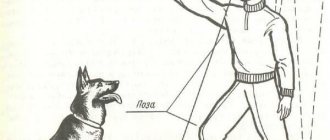Each of us has seen at least once how ugly some dogs behave on the street. They can pull owners, bark at dogs and passers-by, and not hear the owner’s call to come up. The whole point is that the correct upbringing of the animal was not laid down in puppyhood.
As a puppy, raising a dog to suit yourself is quite easy. At this age, the animal’s character has not yet formed, and the pet listens with pleasure to everything that is taught to it. But situations are different, and it may well be that an adult dog with a mature character comes into your home.
The most important thing to understand here is that training an adult dog is also possible. However, it will be necessary to take into account her mature character, and also be patient, because training will take a little more time.
True, sometimes it happens that, in gratitude for a new home, love and care, an adult dog with pleasure begins to quickly grasp new skills and follow commands. Such cases most often occur with animals taken from a shelter, because they are really waiting for their real owners and are ready to do anything for them in the future.
How to train an adult dog?
Many people do not want to get an adult dog, not only because the puppies are cute and they want to have time to “play” with them, but also for fear that an adult dog already has its own character and habits, and they cannot be changed. Because of this fundamentally erroneous judgment, a huge number of wonderful adult dogs still live in shelters, without finding a loving family for a very long time. In fact, you can train and educate a dog at any age; even very adult dogs acquire new necessary skills and give up old habits. Let's look at how to properly train adult dogs.
How to be most successful when training an adult dog?
1. Classes with an experienced dog handler.
Yes, the first thing you need to do is find a professional who will help you build a system of training and education for your dog, based on its specific character, behavior and already established habits. If you do not have experience training dogs, it is better not to try to solve the problem yourself: often, this can only lead to more difficulties or, even worse, to trauma to the dog’s psyche. Of course, videos on the Internet, articles on training, etc. can help you with the correct (note, this is very important!) - precisely the correct - understanding of all the information received, but usually for owners who are not familiar with the basics of animal psychology and training, they either harm, or simply turn out to be useless.
2. You should always start from the very basics.
Even if it seems to you that the dog is well-mannered and knows the basic simplest commands, training should still start with basic tasks. This will help not only to verify the acquired skills and consolidate them, but also to find contact with the dog, teach it to quickly become interested and get involved in the work. If you skip the step of learning the basics, the dog will end up being less controllable and further training will take longer.
3. You need to learn to control your own emotions.
Even people who are far from dog breeding know that dogs are capable of very well capturing the mood of the owner. For example, if you are nervous, your dog will also become anxious, fidgety, and make mistakes. During training, your pet may not understand something for a very long time, he may constantly fail at something - and this is normal, but if you understand that this is starting to make you angry, you are irritated and simply experience negative emotions - the lesson is necessary immediately stop! It is better to return to training later and in a good mood than to discourage your dog from working with you.
4. Regularity of classes.
Many skills and knowledge are retained in dogs throughout their lives, but this does not mean that they do not require regular repetition. Even if a dog knows perfectly well, for example, the “sit” command, but heard it last several months ago, there is a high chance that it will not carry it out, if only because of insufficient motivation. This leads to the following point:
5. Motivation of the dog.
In order for your dog to want to work with you, learn new commands and carry out already learned ones, it must be properly motivated. Let’s make a reservation right away: the only generally acceptable option for motivation is positive reinforcement. Most dogs work great for treats, some are more interested in toys, there are even those for whom the most important thing is simply praise or petting. When training an adult dog, it is best to combine several options for praise at once, for example, praise loudly, out loud, with an exaggerated positive intonation, give a treat, and after completing a set of tasks, be distracted by a game if the dog is interested in it.
Correcting puppy behavior
Correcting a puppy’s behavior involves a set of measures that will help eliminate unwanted behavioral skills in the pet. In essence, this is the education of animals, based on the use of praise, encouragement, and punishment.
Important! Education, unlike training, is a more complex, time-consuming process. With the right systematic approach, you can raise not only an obedient, controllable dog, but also a loyal friend and companion.
Behavior correction is necessary:
- For hyperactive, overly excitable puppies, dogs with an active psyche.
- If the puppy shows aggression towards people, family members, relatives, animals.
- If the dog is not properly socialized.
- If a puppy has fears, phobias, he behaves inappropriately when exposed to strong stimuli. For example, the dog is afraid of other dogs, cars, fireworks, loud noises.
- The puppy has destructive (destructive) behavior. The dog chews furniture and turns over the apartment in the absence of the owners.
- In case of uncleanliness of the dog, if the puppy craps in the house.
Is it possible to train an adult dog?
I would like to immediately note that it is never too late to raise a four-legged friend. With the right approach, an animal can learn simple commands even as an adult or after changing its owner. The only peculiarity of such training is that it is impossible to clearly determine the period during which the dog will master the commands. This time depends not only on age, but also on how the dog was raised up to this point: whether it was taught commands. But, of course, you shouldn’t forget about the pet’s character. With big stubborn people you will have to work more than usual. If you still decide to start raising your pet, then:
- Decide on the purpose of training: either you need a protector, or you just want to teach your pet several commands;
- How and where to train an adult dog: on your own at home or with the help of a specialist in a kennel;
- Decide on your training time. Because only daily, diligent practice will bring results.
If you cannot cope with training yourself, a specialist will help you
Don't mix reward and punishment
Dogs respond better to positive rather than negative reinforcement. Humane training methods give better results than punishment.
Stylish, young, voluminous: shaggy haircuts for thin hair for ladies over 50
Stylish, light and cozy: a couple made a two-tier residential house from an old barn
Good deeds and donations: a quick and easy way to become happier
You should not use both reward and punishment within a short period of time. This mixture of methods confuses the dog. If you behave inconsistently, then the animal cannot understand why it is being rewarded or reprimanded.
If you want a family pet, use mostly positive reinforcement. You should not use harsh methods that are used when training service and guard dogs.
How to train an adult dog yourself: commands
It is better to raise a guard and protector under the supervision of an experienced specialist, rather than at home. Therefore, ko6e4ka.ru will tell you what skills a friend and companion should have.
- The first thing you need to start training your pet with is accustoming it to its place. If your pet habitually lies down on a bed or sofa, then you need to take it to the mat with the words “ Place ”. Every time your pet tries to sit in the wrong place, you need to say “Ugh” and not allow him to do this. And then take him to the mat, constantly repeating “Place.” As praise, it is better to use strokes and warm words, rather than treats, so that this command is carried out correctly;
- The second and easiest command is “ Walk ”. Every time you go for a walk, just repeat “Walk.” It is also necessary to teach the dog to offer its paws for wiping after a walk. To do this, take your pet into the bathroom or wipe its paws with a wet cloth in the hallway, without letting it into the room;
- To establish a more trusting relationship with the owner and to avoid aggression towards other family members, practice the “ Give ” command while feeding. Every time you feed, give the command “Give” in a stern voice and try to move the bowl away. But don’t rush, because if this has not been done to a dog before, it may bite. At the same time, remain calm, since it is simply unacceptable to train an adult dog by screaming. Subsequently, mastering this command will allow you to take even tasty bones from the dog. And don’t forget to praise your pet for correctly executed commands.
- Also, during feeding, you can practice the “ Fu ” command, which is very useful during walks in the fresh air, when the pet decides to pick up something from the ground;
- How to best train an adult dog while walking. Using a long leash, you can practice the “ Come to me ” command. In this situation, a long leash will allow you to pull your pet towards you when pronouncing the command. This way you can show the dog exactly what is required of him.
- Also, while walking on a leash, you can learn the “ Near ” command. To do this, it is better to wrap the leash around your hand and lead the dog next to you, saying “Nearby.” And use stroking as a reward for obedience;
- Later you can master the “ Sit ” command. To do this, you need to call the dog, give the command “Sit” and extend your hand with a treat so that it is raised a little back (almost above its back). The animal will raise its head and sit down to make it easier to watch. Praise your pet and give him a treat. You should not repeat this command more than three times, as the animal will get tired and stop obeying;
- Only after mastering the “Sit” command can you move on to the “ Lie down ” command. To do this, show the sitting pet a treat and extend your hand forward, and then down and say “Lie down.”
Preparation
To prepare your dog for the training process, run him a few laps around the stadium and give him a good walk. But as for time, it’s better to choose it for yourself. During the summer, it is better not to carry out training during the daytime, but if that is when you have free time, stock up on water.
Why do you need a litter box for dogs? What types of trays are there and why is there grass in the tray?
An article about what types of shepherd dogs exist and what their features are.
How to properly train an adult dog: useful tips
- If you decide to start training your adult dog, then be patient and prepare for the fact that training needs to be done daily. But they should take no more than half an hour a day.
- Commands must be spoken in a calm, confident voice.
- Do not shout or hit the dog under any circumstances.
- Use appropriate incentives for each team. For example, when using the “Nearby” command, you shouldn’t feed the dog treats all the way. Use small treats so that the animal does not overeat.
Now you know how to train an adult dog. Spending time together in this way will not only give you pleasure, but also raise a devoted friend and an irreplaceable assistant.
Bruslik Maria - especially for Koshechka.ru - a site for those in love... with themselves!
Duration of classes
The more often you exercise your dog, the better. The minimum you need to do is 20 to 60 minutes a day. They start with short training and gradually increase the time.
A well-trained dog is not only convenient, but also safe. A trained dog may well save the owner's life.
Classes with a professional
How to train an adult dog?
Each of us has seen at least once how ugly some dogs behave on the street. They can pull owners, bark at dogs and passers-by, and not hear the owner’s call to come up. The whole point is that the correct upbringing of the animal was not laid down in puppyhood.
As a puppy, raising a dog to suit yourself is quite easy. At this age, the animal’s character has not yet formed, and the pet listens with pleasure to everything that is taught to it. But situations are different, and it may well be that an adult dog with a mature character comes into your home.
The most important thing to understand here is that training an adult dog is also possible. However, it will be necessary to take into account her mature character, and also be patient, because training will take a little more time.
True, sometimes it happens that, in gratitude for a new home, love and care, an adult dog with pleasure begins to quickly grasp new skills and follow commands. Such cases most often occur with animals taken from a shelter, because they are really waiting for their real owners and are ready to do anything for them in the future.
Carrot or stick - which method to choose
A rhetorical question. Just 10-15 ago, all dog handlers spoke in unison about “dominance” and that a dog must respect its owner. Today, the situation has changed dramatically; an increasing number of animal psychologists are confident that you need to raise a dog through positivity .
Properly selected motivation makes the dog carry out commands with joy, which even looks more impressive. When a pet is raised without the use of a “whip”, he is absolutely confident in himself and has unlimited trust in his owner. By replacing the “carrot” with cruelty, there is a high chance of getting a frightened, nervous creature that, at any opportunity, tries to escape from its owner.
Where to start training an adult dog?
You must choose a specific time for training. It is advisable to train an adult dog daily. The process itself should be built in several stages during the walk:
- game;
- training with the owner;
- command training.
The owner of his pet can teach a basic training course. To do this, you should stock up on pieces of goodies, which will be given out for correct execution of the command.
If we are talking about more serious types of training, then you cannot do without the help of an experienced dog trainer who will help you train your dog properly during the course.
You don't repeat learned skills
Training your pet has a cumulative effect. Even if the dog has mastered the commands well, it needs to be trained regularly. You should not teach an animal several skills at once. You can teach your dog something new, but periodically you need to return to what you have learned and repeat the execution of already mastered commands.
Names must be unusual: Polar bear cubs are asked to come up with names
The Arctic could become green again, scientists say
Jewish money wisdom: possession of information is an indispensable weapon in business
Rules you need to know when training
Some commands should be started to be practiced at home. On the street, where there are a lot of outside noises, smells and temptations, an adult dog may well ignore your wishes. For example, the command “near!” should be mastered in an apartment where the animal is maximally concentrated on its owner.
Also the command “come to me!” starts teaching at home. By analogy with the previous command, the owner must take a piece of sausage, dog biscuits or something else that is a treat, and call the pet to him, while giving him a treat.
The simplest commands include “give me your paw!”, “sit!” or “lie down!” The animal masters these tasks perfectly at any age if contact is established between him and the owner.
On the street, you can begin to master the “apport!” command, which animals love without exception, because it is a kind of game for them. All of the above commands are also performed on the street, but after they have been mastered at home.
Training an adult guard dog
There are many breeds of dogs bred specifically to guard and protect their owners. In this case, it is advisable to start training from an early age. If the animal comes to you as an adult, you should not despair, just as you should not make it into a spoiled creature, incapable of anything, frightening everyone only with its evil appearance.
Owners of large dogs should know that training in this case is simply necessary, otherwise the pet may pose a threat. Only an experienced dog handler can provide proper training. You cannot independently undertake the development of security skills in an adult dog, as there is a high risk of damaging the animal’s psyche.
Together with the instructor, the owner will have to follow all commands, thereby preparing his dog for absolute obedience. In this case, you will get a well-bred dog with a stable psyche, who will serve faithfully and will not frighten other people.
Choosing a collar for a rowdy
A leash, muzzle, and collar are indispensable attributes for walking and training dogs. The choice of collar depends on the breed, size, character traits, and temperament of the dog. Pay attention to the quality parameters of the material.
Important! The collar should be comfortable for the dog and fit in size.
- For disobedient medium and large dogs, wide canvas, leather collars, leatherette collars with durable fasteners and a welded steel ring are suitable for daily walks. The ring should be removed from the clasp.
- For small dogs - walking harness, strap models made of elastic soft leather.
- For training, practicing commands, and correcting behavior, purchase a strict collar (parfos), a choke collar or half-choke, in which the loop is not fully tightened around the dog’s neck. Choke collars are made of fabric materials, leather, metal (snatch chains). Half-chokes can be made from a combination of leather and metal.











